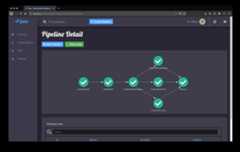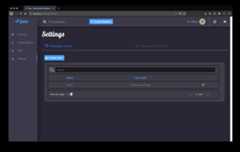- Notifications
You must be signed in to change notification settings - Fork244
Build powerful pipelines in any programming language.
License
gaia-pipeline/gaia
Folders and files
| Name | Name | Last commit message | Last commit date | |
|---|---|---|---|---|
Repository files navigation
Gaia is an open source automation platform which makes it easy and fun to build powerful pipelines in any programming language. Based onHashiCorp's go-plugin andgRPC, gaia is efficient, fast, lightweight, and developer friendly.
Develop powerfulpipelines with the help ofSDKs and simply check-in your code into a git repository. Gaia automatically clones your code repository, compiles your code to a binary, and executes it on-demand. All results are streamed back and formatted as a user-friendly graphical output.
Check outgaia-pipeline.io to learn more.
Automation Engineer,DevOps Engineer,SRE,Cloud Engineer,Platform Engineer - they all have one in common:The majority of tech people are not motivated to take up this work and they are hard to recruit.
One of the main reasons for this is the abstraction and poor execution of many automation tools. They come with their own configuration (YAML syntax) specification or limit the user to one specific programming language. Testing is nearly impossible because most automation tools lack the ability to mock services and subsystems. Even tiny things, for example parsing a JSON file, are sometimes really painful because external, outdated libraries were used and not included in the standard framework.
We believe it's time to remove all those abstractions and come back to our roots. Are you tired of writing endless lines of YAML-code? Are you sick of spending days forced to write in a language that does not suit you and is not fun at all? Do you enjoy programming in a language you like? Then Gaia is for you.
Gaia is based onHashiCorp's go-plugin. It's aplugin system that usesgRPC to communicate overHTTP/2. Initially, HashiCorp developed this tool forPacker but now it's heavily used byTerraform,Nomad, andVault too.
Plugins, also calledpipelines, are applications which can be written in any programming language, as long asgRPC is supported. All functions, also calledjobs, are exposed to Gaia and can form up a dependency graph that describes the order of execution.
Pipelines can be compiled locally or simply over the integrated build system. Gaia clones the git repository and automatically builds the included pipeline. If a change (git push) happened, Gaia will automatically rebuild the pipeline for you*.
After a pipeline has been started, all log output is returned back to Gaia and displayed in a detailed overview with their final result status.
Gaia uses boltDB for storage. This makes the installation process super easy. No external database is currently required.
*This requires polling or webhook to be activated.
The installation of gaia is simple and often takes a few minutes.
The following command starts gaia as a daemon process and mounts all data to the current folder. Afterwards, gaia will be available on the host system on port 8080. Use the standard useradmin and passwordadmin as initial login. It is recommended to change the password afterwards.
docker run -d -p 8080:8080 -v$PWD:/data gaiapipeline/gaia:latestThis uses the image with thelatest tag which includes all required libraries and compilers for all supported languages. If you prefer a smaller image suited for your preferred language, have a look at theavailable docker image tags.
It is possible to install Gaia directly on the host system.This can be achieved by downloading the binary from thereleases page.
Gaia will automatically detect the folder of the binary and will place all data next to it. You can change the data directory with the startup parameter-home-path if you want.
If you haven't got an ingress controller pod yet, make sure that you have kube-dns or coredns enabled, run this command to set it up.
make kube-ingress
To init helm:
helm init
To deploy gaia:
make deploy-kube
package mainimport ("log" sdk"github.com/gaia-pipeline/gosdk")// This is one job. Add more if you want.funcDoSomethingAwesome(args sdk.Arguments)error {log.Println("This output will be streamed back to gaia and will be displayed in the pipeline logs.")// An error occurred? Return it back so gaia knows that this job failed.returnnil}funcmain() {jobs:= sdk.Jobs{ sdk.Job{Handler:DoSomethingAwesome,Title:"DoSomethingAwesome",Description:"This job does something awesome.", }, }// Serveiferr:=sdk.Serve(jobs);err!=nil {panic(err) }
}
fromgaiasdkimportsdkimportloggingdefMyAwesomeJob(args):logging.info("This output will be streamed back to gaia and will be displayed in the pipeline logs.")# Just raise an exception to tell Gaia if a job failed.# raise Exception("Oh no, this job failed!")defmain():logging.basicConfig(level=logging.INFO)myjob=sdk.Job("MyAwesomeJob","Do something awesome",MyAwesomeJob)sdk.serve([myjob])
packageio.gaiapipeline;importio.gaiapipeline.javasdk.*;importjava.util.ArrayList;importjava.util.Arrays;importjava.util.logging.Logger;publicclassPipeline{privatestaticfinalLoggerLOGGER =Logger.getLogger(Pipeline.class.getName());privatestaticHandlerMyAwesomeJob = (gaiaArgs) -> {LOGGER.info("This output will be streamed back to gaia and will be displayed in the pipeline logs.");// Just raise an exception to tell Gaia if a job failed.// throw new IllegalArgumentException("Oh no, this job failed!"); };publicstaticvoidmain(String[]args ) {PipelineJobmyjob =newPipelineJob();myjob.setTitle("MyAwesomeJob");myjob.setDescription("Do something awesome.");myjob.setHandler(MyAwesomeJob);Javasdksdk =newJavasdk();try {sdk.Serve(newArrayList<>(Arrays.asList(myjob))); }catch (Exceptionex) {ex.printStackTrace(); } }}
#include"cppsdk/sdk.h"#include<list>#include<iostream>voidDoSomethingAwesome(std::list<gaia::argument> args) throw(std::string) { std::cerr <<"This output will be streamed back to gaia and will be displayed in the pipeline logs." << std::endl;// An error occurred? Return it back so gaia knows that this job failed.// throw "Uhh something badly happened!"}intmain() { std::list<gaia::job> jobs; gaia::job awesomejob; awesomejob.handler = &DoSomethingAwesome; awesomejob.title ="DoSomethingAwesome"; awesomejob.description ="This job does something awesome."; jobs.push_back(awesomejob);try {gaia::Serve(jobs); }catch (string e) { std::cerr <<"Error:" << e << std::endl; }}
require'rubysdk'classMainAwesomeJob=lambdado |args|STDERR.puts"This output will be streamed back to gaia and will be displayed in the pipeline logs."# An error occurred? Raise an exception and gaia will fail the pipeline.# raise "Oh gosh! Something went wrong!"enddefself.mainawesomejob=Interface::Job.new(title:"Awesome Job",handler:AwesomeJob,desc:"This job does something awesome.")beginRubySDK.Serve([awesomejob])rescue=>eputs"Error occured:#{e}"exit(false)endendend
constnodesdk=require('@gaia-pipeline/nodesdk');functionDoSomethingAwesome(args){console.error('This output will be streamed back to gaia and will be displayed in the pipeline logs.');// An error occurred? Throw it back so gaia knows that this job failed.// throw new Error('My error message');}// Servetry{nodesdk.Serve([{handler:DoSomethingAwesome,title:'DoSomethingAwesome',description:'This job does something awesome.'}]);}catch(err){console.error(err);}
Pipelines are defined by jobs and a function usually represents a job. You can define as many jobs in your pipeline as you want.
Every function accepts arguments. Those arguments can be requested from the pipeline itself and the values are passed back in from the UI.
Some pipeline jobs need a specific order of execution. DependsOn allows you to declare dependencies for every job.
You can find real examples and more information onhow to develop a pipeline in the docs.
See the Documentation located here:security-docs.
Please find the docs athttps://docs.gaia-pipeline.io. We also have a tutorials section over there with examples and real use-case scenarios. For example,Kubernetes deployment with vault integration.
Literally every tool that was designed for automation, continuous integration (CI), and continuous deployment (CD) like Spinnaker, Jenkins, Gitlab CI/CD, TravisCI, CircleCI, Codeship, Bamboo and many more, introduced their own configuration format. Some of them don't even supportconfiguration/automation as code. This works well for simple tasks like running ago install ormvn clean install but in the real world there is more to do.
Gaia is the first platform that does not limit the user and provides full support for almost all common programming languages without losing the features offered by todays CI/CD tools.
A pipeline is a real application with at least one function (we call it a Job). Every programming language can be used as long as gRPC is supported. We offer SDKs to support the development.
A job is a function, usually globally exposed to Gaia. Dependent on the dependency graph, Gaia will execute this function in a specific order.
The SDK implements the Gaia plugin gRPC interface and offers helper functions like serving the gRPC-Server. This helps you to focus on the real problem instead of doing the boring stuff.
We currently fully support Go, Java, Python, C++, Ruby and Node.JS.
We are working hard to support as much programming languages as possible but our resources are limited and we are also mostly no experts in all programming languages. If you are willing to contribute, feel free to open an issue and start working.
Gaia is currently available as beta version.
Feel free to open a new GitHub issue to request a new feature.
Gaia can only evolve and become a great product with the help of contributors. If you like to contribute, please have a look at ourissues section. We do our best to mark issues for new contributors with the labelgood first issue.
If you think you found a good first issue, please consider this list as a short guide:
- If the issue is clear and you have no questions, please leave a short comment that you started working on this. The issue will be usually blocked for two weeks for you to solve it.
- If something is not clear or you are unsure what to do, please leave a comment so we can add more detailed description.
- Make sure your development environment is configured and set up. You needGo installed on your machine and alsonodeJS for the frontend. Clone this repository and run themake command inside the cloned folder. This will start the backend. To start the frontend you have to open a new terminal window and go into the frontend folder. There you runnpm install and thennpm run serve. This should automatically open a new browser window.
- Before you start your work, you should fork this repository and push changes to your fork. Afterwards, send a merge request back to upstream.
If you have any questions feel free to contact us onslack.
About
Build powerful pipelines in any programming language.
Topics
Resources
License
Uh oh!
There was an error while loading.Please reload this page.
Stars
Watchers
Forks
Packages0
Uh oh!
There was an error while loading.Please reload this page.







